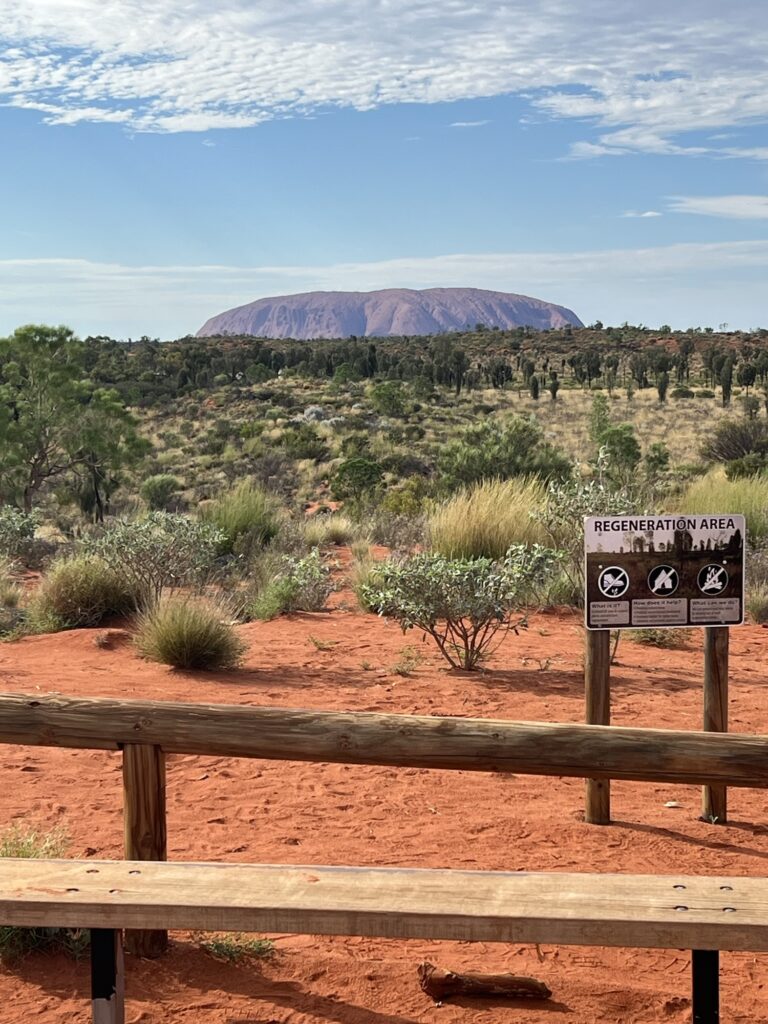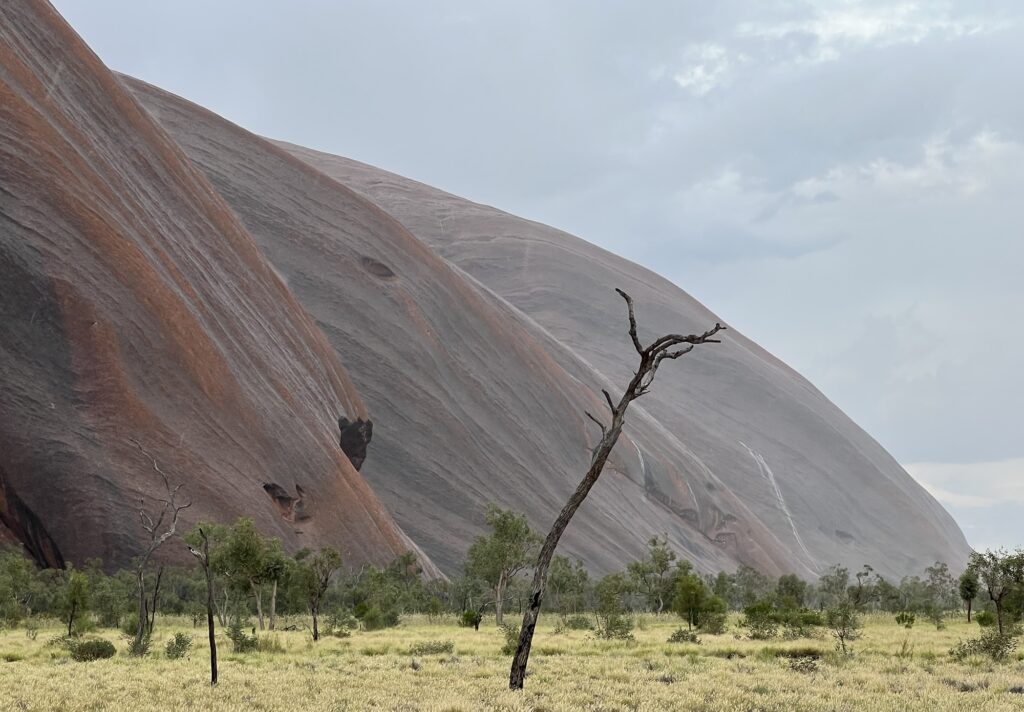Today – Sunday, December 12th (Australian Central Time) – I’ve mostly spent exploring the environs around Ayes Rock and the Ayres Rock Resort. Some of my adventures have been under my own steam, and some have been from the selection of various paid-for tours provided by AAT Kings. Each has been thought-provoking, emotional and/or cathartic in varying degrees and for a number of different reasons. But above all else, they’ve certainly been enjoyable 😎
At this point, I’d like to give a big shout-out to Jacinta at AAT Kings. You might recall me saying that things don’t always go to plan – especially on Adventure Vacations – and that you just have to “roll with the punches” when they don’t. I’ve found it really is the only way to stay sane and to keep on enjoying one’s vacation overall. Those of you following along might recall that in Melbourne, it was my trip along the Great Ocean Road that ran into some speed bumps; here at Uluru, it was my Sunrise/Field of Light trip that had some issues. Needless to say, though, everything got sorted, and to date, I’ve been so very impressed by how proactive the tour operators are over here in Aus; “Good on ya, mate” is, I think, how the saying goes! 😎
Field of Light
Setting off at 4:30 am, with our first – and actually only – stop being the Field of Light, our trusty steed – ably aided and abetted by our trusted guides from AAT – delivered us en masse, some 10 minutes down the road from the Ayres Rock Resort.

Bruce Munro is an internationally acclaimed artist who mostly works with light, and I first came across his work as part of an exhibition incorporating his iconic “Field of Light” that was being hosted at Marston Park (a stately home and grounds near where I live in the UK). So imagine my intrigue when I heard that Uluru was home to a more permanent installation of his iconic work 😎





“Field of Light” is created by utilizing a myriad of fibre-optic cables connecting purpose-built translucent glass-like spheres that sit atop illuminated glass-like stalks. Each sphere carries a small cluster of LEDs, and everything gently changes colour over time. As someone who’s built my own custom lighting feature – for a stage show I directed called Constellations (you can take a look at my Scenic Lighting promo here) – I know how much work can go into something like this. I also know how awesome the effect(s) that are created can be! 😎
Like most of his other installations, the one at Uluru is solar-powered, and it comes “alive” before dawn and again once the Sun has set. If you get the chance to see one of his creations, I would highly recommend doing so; the experience is both tranquil and mesmerizing in equal measure.
Sunrise
As dawn approached, we progressively made our way up to the viewing point overlooking the now-dimming “Field of Light”, where tea, coffee and other refreshments were waiting. And with the sky beginning to lighten, we bore witness to the great red rock greeting the rising Sun, as it had done for thousands of years before…and will most likely do for thousands of years to come!



Heading back onboard our trusty metal mount, us group of dawn explorers took the short trip back to the Ayres Rock Resort and our respective accommodation as our “Sunrise & Field of Light” came to a close.



Some Self Exploration
With a few hours to kill before my next excursion, I decided to explore the immediate area around Desert Gardens and the Ayres Rock Resort. Heading out along any one of the Bush Trails provides a great opportunity to survey the immediate surroundings and also offers the chance for some quiet reflection and introspection, sat in the relative tranquillity of the outback.



There are also some interesting things to do and see around the resort, too – most of which are free, but some of which are scheduled for particular times or happen only after dark.



Sacred Sites
At 3:15 p.m., the folks from AAT returned to collect me and my fellow adventurers for the second excursion of the day, this time to explore Uluru and its surrounding environs.
The Indigenous Anangu (pronounced arn-ung-oo) people are the traditional and, once again, legal landowners of Uluru-Kata Tjuta National Park – the National Park in which Uluru (Ayres Rock) can be found. Uluru is an important and sacred site for the Anangu and is one that has existed since “the beginning of time” – western science dating it back to around 300 million years ago. The park itself also contains many sacred places that only the Anangu are permitted to venture.
The National Park was created in 1950, and at that time, the Anangu people were encouraged to avoid the area and stop visiting. The land was effectively taken from them! 😳 Naturally, this caused much hurt and upset, and eventually, the national park was handed back to the Anangu people on October 26th, 1985 – the title deeds to the park being presented by the then Governor-General of Australia, Sir Ninian Stephen, in a ceremony conducted under the shadow of Uluru itself. The park is now managed by a board that includes representatives from the Australian Government, the Australian Tourist Board, and the Anangu people themselves. You can read about this and more here at deadlystory.com.
The Anangu tell many stories of Uluru and how it was formed, but only some of these do they share with anyone outside their communities. Out of respect, photography is also prohibited at many of the locations sacred to these Indigenous tribes – the Uluru-Kata Tjuta Cultural Centre, built in consultation with them – being one of those. However, there are still spots where photography is allowed, and these provide some amazing opportunities to capture what is, without question, a captivating experience.



The stories of Uluru include tales of Lungkata, Kuniya and Liru, the god-like ancestral beings whose adventures created the world, the features and creatures within, and who could transform themselves to exist amongst mortal man…often as snakes or other desert creatures.
One such tale – the story of Kuniya and Liru – tells of Kuniya, who, camped at Taputji and hunting in the nearby hills, was called to Uluru in snake-like form, entering the Muṯitjulu Waterhole and creating deep grooves in the rock as she did so. There, she began a dance of immense power and magic, battling the Liru – or venomous brown snake – that had struck a mortal blow to her nephew (who was also a Kuniya), and eventually striking her enemy dead. Tjukuritja – the physical evidence of such ancestral stories – can still be seen in and around the rock today.


Whilst the Anangu may have discovered many things and shared their stories about those discoveries, too, any solution to the fly situation – which is particularly significant around Uluru at this time of year – has been lost to the mists of time. Or simply not shared with the likes of us! 🤦🏻♂️
Park Pass
To enter the Uluru-Kata Tjuta National Park, whether under your own steam or as part of a tour, requires the purchase of a “park pass”. This is a relatively straightforward affair, and if one chooses to do so using their Apple mobile (other devices are also supported 😉), it can even be added to Apple Wallet, too!

Sunset
One thing that is almost impossible to predict is the weather, and as our tour was coming to a close, the heavens opened! Unfortunately, the accompanying cloud cover meant that watching the setting sun was sadly not to be. Amazingly, however, the rain – a less than common occurrence generally, let alone this time of year – transformed Uluru before our very eyes! And gave us a rare opportunity to glimpse the magnificent waterfalls that can form as well as the spectacular transformation the rock can undergo 😮 Truly an amazing sight!

Leave a Reply